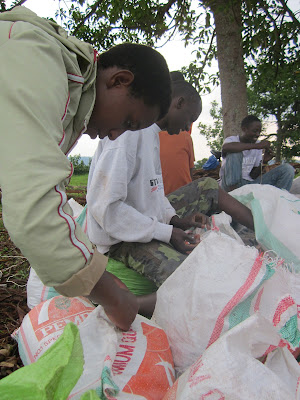The History Nature Park
The ASYV Nature Park was formed in 2011 by over 300 ASYV students and staff. All 24 families helped to make the park trail, remove lantanta, and/or plant trees over the course of May-October 2011 during Saturday Service events. The Nature Park is 1.72 hectares (4.26 acres) and is 1558 to 1597 meters above sea level. There are over 72 established native and fruit trees in the park, not included those planted in 2011-2012. Around 90 species of birds have been observed in the Park as well as toads, skinks, striped mouse species, bats, mongoose and different types of insects.
Park Goals
Social Vision for the Park
To get people involved. If people enjoy the park, they will keep it .The park has many opportunities for learning (formally and informally), enjoying (art, relaxation, walks, eating fruits) and doing Saturday service (clearing trail, removing lantana, caring for the trees).
" You cannot protect the environment unless you empower people, you inform them, and you help them understand that these resources are their own. That they must protect them." Wangari Maathai
Park To Do (during Saturday Service or other times)
 |
| Trail head sign at the Nature Park |
Park Goals
- To provide a space for the Environment Club to explore, enjoy and educate others about the environment.
- To provide a space for students, staff, and volunteers to relax and enjoy the outdoors.
- To provide a training opportunity for skills in forestry, wildlife management, ecotourism, park management, and other fields.
Ecological Vision for the Park
In 10-20 years, the Nature Park should be mature enough so that cavity/tree nesting birds such as hornbills, woodpeckers, turacos, barbets, parrots will return to this area, to live in the Nature Park. Not only would the local biodiversity benefit, but these are iconic birds that people tend to enjoy. These species are also good indicators of ecosystem health. Their habitat is dominated by trees and these trees provide fruit and shade to people. In order to accomplish this the park needs native trees similar to other remaining native forest areas, i.e. Akagera National Park Hills, Kibungo Valley and lower areas of Nyungwe. These native trees need to be planted and they need to be protected so they grow to maturity. |
| A small Acacia tree growing. In several years this will provide a nice shady spot. |
Social Vision for the Park
To get people involved. If people enjoy the park, they will keep it .The park has many opportunities for learning (formally and informally), enjoying (art, relaxation, walks, eating fruits) and doing Saturday service (clearing trail, removing lantana, caring for the trees).
" You cannot protect the environment unless you empower people, you inform them, and you help them understand that these resources are their own. That they must protect them." Wangari Maathai
Park To Do (during Saturday Service or other times)
- maintain trail so to prevent the park from being cultivated or grazed. Unfortunately the fence was stolen in 2012 but a living fence was planted in September 2012.
- Maintain native trees and fruit trees (and plant more where necessary)
- Remove lantana
- Make park accessible to people (sign, benches, trails). Get people in it (to enjoy and help keep it as a community resource)
2012 Vision
This year in the Nature Park the goal was to add, improve and maintain last year's achievements. So far this year, the Environment Club with the help of 16 families have:
This year in the Nature Park the goal was to add, improve and maintain last year's achievements. So far this year, the Environment Club with the help of 16 families have:
- made new signs to direct visitors and ASYV staff/students to the Nature Park
- made a new walking trail, and start tree seeds to plant in the Nature Park
- cleared lantana (invasive species)
- planted a living fence around the Nature Park
- guided visitors on nature tours of the park
- researched trees and animals of the park to make interpretive signs
Currently there are two projects that are being completed in the Nature Park. One is to finish some interpretive signs for the park. The other is to make a Natural Building meeting space just outside the park. This meeting area is to encourage more students, staff and visitors to come to the Nature Park and teach a core team of students natural building skills along side with leadership, teamwork and responsibility.
 |
| Sewing bags filled with soil. One of the natural building techniques we are using is called rammed earth or earth bag construction. |
 |
| Mixing cement to hold the poles for the building secure. |


No comments:
Post a Comment